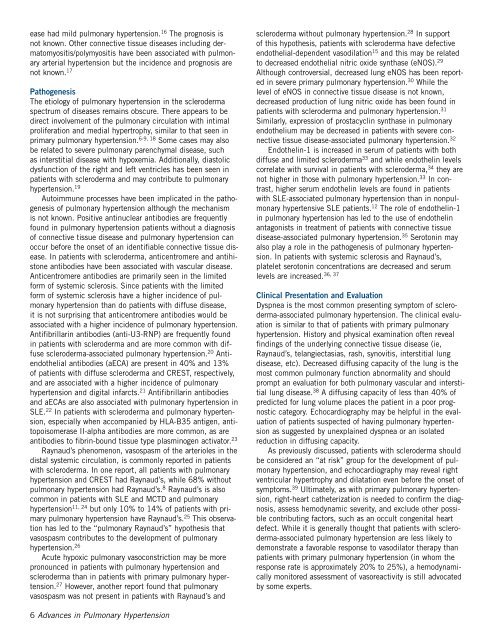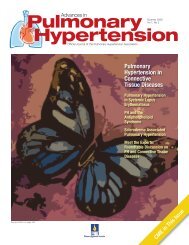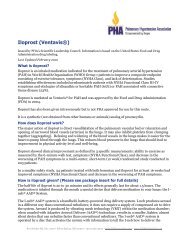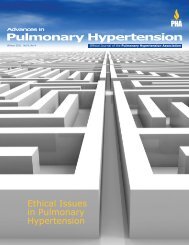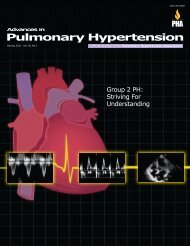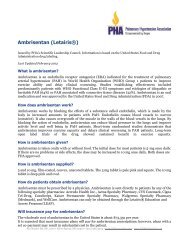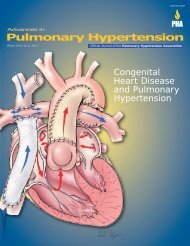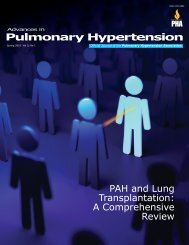Advances in Pulmonary Hypertension - PHA Online University
Advances in Pulmonary Hypertension - PHA Online University
Advances in Pulmonary Hypertension - PHA Online University
You also want an ePaper? Increase the reach of your titles
YUMPU automatically turns print PDFs into web optimized ePapers that Google loves.
ease had mild pulmonary hypertension. 16 The prognosis is<br />
not known. Other connective tissue diseases <strong>in</strong>clud<strong>in</strong>g dermatomyositis/polymyositis<br />
have been associated with pulmonary<br />
arterial hypertension but the <strong>in</strong>cidence and prognosis are<br />
not known. 17<br />
Pathogenesis<br />
The etiology of pulmonary hypertension <strong>in</strong> the scleroderma<br />
spectrum of diseases rema<strong>in</strong>s obscure. There appears to be<br />
direct <strong>in</strong>volvement of the pulmonary circulation with <strong>in</strong>timal<br />
proliferation and medial hypertrophy, similar to that seen <strong>in</strong><br />
primary pulmonary hypertension. 6-9, 18 Some cases may also<br />
be related to severe pulmonary parenchymal disease, such<br />
as <strong>in</strong>terstitial disease with hypoxemia. Additionally, diastolic<br />
dysfunction of the right and left ventricles has been seen <strong>in</strong><br />
patients with scleroderma and may contribute to pulmonary<br />
hypertension. 19<br />
Autoimmune processes have been implicated <strong>in</strong> the pathogenesis<br />
of pulmonary hypertension although the mechanism<br />
is not known. Positive ant<strong>in</strong>uclear antibodies are frequently<br />
found <strong>in</strong> pulmonary hypertension patients without a diagnosis<br />
of connective tissue disease and pulmonary hypertension can<br />
occur before the onset of an identifiable connective tissue disease.<br />
In patients with scleroderma, anticentromere and antihistone<br />
antibodies have been associated with vascular disease.<br />
Anticentromere antibodies are primarily seen <strong>in</strong> the limited<br />
form of systemic sclerosis. S<strong>in</strong>ce patients with the limited<br />
form of systemic sclerosis have a higher <strong>in</strong>cidence of pulmonary<br />
hypertension than do patients with diffuse disease,<br />
it is not surpris<strong>in</strong>g that anticentromere antibodies would be<br />
associated with a higher <strong>in</strong>cidence of pulmonary hypertension.<br />
Antifibrillar<strong>in</strong> antibodies (anti-U3-RNP) are frequently found<br />
<strong>in</strong> patients with scleroderma and are more common with diffuse<br />
scleroderma-associated pulmonary hypertension. 20 Antiendothelial<br />
antibodies (aECA) are present <strong>in</strong> 40% and 13%<br />
of patients with diffuse scleroderma and CREST, respectively,<br />
and are associated with a higher <strong>in</strong>cidence of pulmonary<br />
hypertension and digital <strong>in</strong>farcts. 21 Antifibrillar<strong>in</strong> antibodies<br />
and aECAs are also associated with pulmonary hypertension <strong>in</strong><br />
SLE. 22 In patients with scleroderma and pulmonary hypertension,<br />
especially when accompanied by HLA-B35 antigen, antitopoisomerase<br />
II-alpha antibodies are more common, as are<br />
antibodies to fibr<strong>in</strong>-bound tissue type plasm<strong>in</strong>ogen activator. 23<br />
Raynaud’s phenomenon, vasospasm of the arterioles <strong>in</strong> the<br />
distal systemic circulation, is commonly reported <strong>in</strong> patients<br />
with scleroderma. In one report, all patients with pulmonary<br />
hypertension and CREST had Raynaud’s, while 68% without<br />
pulmonary hypertension had Raynaud’s. 8 Raynaud’s is also<br />
common <strong>in</strong> patients with SLE and MCTD and pulmonary<br />
hypertension 11, 24 but only 10% to 14% of patients with primary<br />
pulmonary hypertension have Raynaud’s. 25 This observation<br />
has led to the “pulmonary Raynaud’s” hypothesis that<br />
vasospasm contributes to the development of pulmonary<br />
hypertension. 26<br />
Acute hypoxic pulmonary vasoconstriction may be more<br />
pronounced <strong>in</strong> patients with pulmonary hypertension and<br />
scleroderma than <strong>in</strong> patients with primary pulmonary hypertension.<br />
27 However, another report found that pulmonary<br />
vasospasm was not present <strong>in</strong> patients with Raynaud’s and<br />
6 <strong>Advances</strong> <strong>in</strong> <strong>Pulmonary</strong> <strong>Hypertension</strong><br />
scleroderma without pulmonary hypertension. 28 In support<br />
of this hypothesis, patients with scleroderma have defective<br />
endothelial-dependent vasodilation15 and this may be related<br />
to decreased endothelial nitric oxide synthase (eNOS). 29<br />
Although controversial, decreased lung eNOS has been reported<br />
<strong>in</strong> severe primary pulmonary hypertension. 30 While the<br />
level of eNOS <strong>in</strong> connective tissue disease is not known,<br />
decreased production of lung nitric oxide has been found <strong>in</strong><br />
patients with scleroderma and pulmonary hypertension. 31<br />
Similarly, expression of prostacycl<strong>in</strong> synthase <strong>in</strong> pulmonary<br />
endothelium may be decreased <strong>in</strong> patients with severe connective<br />
tissue disease-associated pulmonary hypertension. 32<br />
Endothel<strong>in</strong>-1 is <strong>in</strong>creased <strong>in</strong> serum of patients with both<br />
diffuse and limited scleroderma33 and while endothel<strong>in</strong> levels<br />
correlate with survival <strong>in</strong> patients with scleroderma, 34 they are<br />
not higher <strong>in</strong> those with pulmonary hypertension. 33 In contrast,<br />
higher serum endothel<strong>in</strong> levels are found <strong>in</strong> patients<br />
with SLE-associated pulmonary hypertension than <strong>in</strong> nonpulmonary<br />
hypertensive SLE patients. 12 The role of endothel<strong>in</strong>-1<br />
<strong>in</strong> pulmonary hypertension has led to the use of endothel<strong>in</strong><br />
antagonists <strong>in</strong> treatment of patients with connective tissue<br />
disease-associated pulmonary hypertension. 35 Seroton<strong>in</strong> may<br />
also play a role <strong>in</strong> the pathogenesis of pulmonary hypertension.<br />
In patients with systemic sclerosis and Raynaud’s,<br />
platelet seroton<strong>in</strong> concentrations are decreased and serum<br />
36, 37<br />
levels are <strong>in</strong>creased.<br />
Cl<strong>in</strong>ical Presentation and Evaluation<br />
Dyspnea is the most common present<strong>in</strong>g symptom of scleroderma-associated<br />
pulmonary hypertension. The cl<strong>in</strong>ical evaluation<br />
is similar to that of patients with primary pulmonary<br />
hypertension. History and physical exam<strong>in</strong>ation often reveal<br />
f<strong>in</strong>d<strong>in</strong>gs of the underly<strong>in</strong>g connective tissue disease (ie,<br />
Raynaud’s, telangiectasias, rash, synovitis, <strong>in</strong>terstitial lung<br />
disease, etc). Decreased diffus<strong>in</strong>g capacity of the lung is the<br />
most common pulmonary function abnormality and should<br />
prompt an evaluation for both pulmonary vascular and <strong>in</strong>terstitial<br />
lung disease. 38 A diffus<strong>in</strong>g capacity of less than 40% of<br />
predicted for lung volume places the patient <strong>in</strong> a poor prognostic<br />
category. Echocardiography may be helpful <strong>in</strong> the evaluation<br />
of patients suspected of hav<strong>in</strong>g pulmonary hypertension<br />
as suggested by unexpla<strong>in</strong>ed dyspnea or an isolated<br />
reduction <strong>in</strong> diffus<strong>in</strong>g capacity.<br />
As previously discussed, patients with scleroderma should<br />
be considered an “at risk” group for the development of pulmonary<br />
hypertension, and echocardiography may reveal right<br />
ventricular hypertrophy and dilatation even before the onset of<br />
symptoms. 39 Ultimately, as with primary pulmonary hypertension,<br />
right-heart catheterization is needed to confirm the diagnosis,<br />
assess hemodynamic severity, and exclude other possible<br />
contribut<strong>in</strong>g factors, such as an occult congenital heart<br />
defect. While it is generally thought that patients with scleroderma-associated<br />
pulmonary hypertension are less likely to<br />
demonstrate a favorable response to vasodilator therapy than<br />
patients with primary pulmonary hypertension (<strong>in</strong> whom the<br />
response rate is approximately 20% to 25%), a hemodynamically<br />
monitored assessment of vasoreactivity is still advocated<br />
by some experts.


